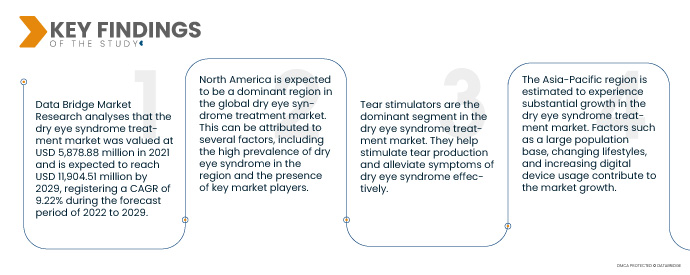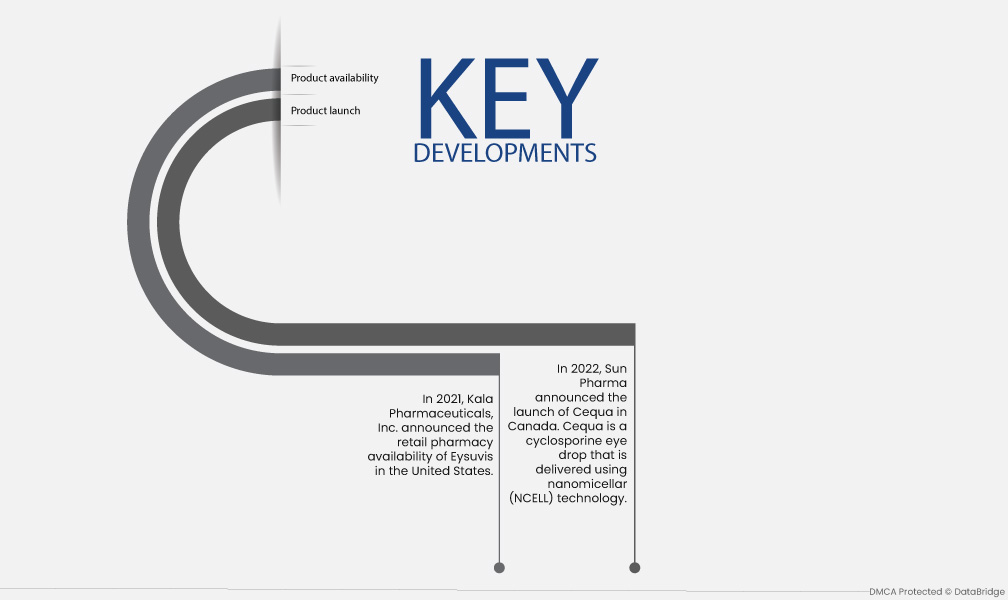In 2021, the retail pharmacies segment had the highest revenue share of 45.1%. This is due to the convenience of retail pharmacies. Furthermore, the existence of chemists in some locations to aid with doses, customer service, and consultations helps the segment acquire a competitive edge in the market. The online pharmacies segment is expected to develop at the quickest pace of 8.4% during the forecast period, owing to an increase in consumers purchasing items for convenience. Furthermore, due to constraints on people's movement, the epidemic has increased the use of online pharmacies. Furthermore, the availability of lower prices in these online retailers encourages recurring buying.
Access Full Report at https://databridgemarketresearch.com/reports/global-dry-eye-syndrome-treatment-market
Data Bridge Market Research analyses that the Dry Eye Syndrome Treatment Market was valued at USD 5,878.88 million in 2021 and is expected to reach USD 11,904.51 million by 2029, registering a CAGR of 9.22% during the forecast period of 2022 to 2029. The global dry eye syndrome treatment market is expected to witness significant growth due to the rising prevalence of dry eye syndrome and the introduction of advanced treatment options. Technological advancements and increasing awareness campaigns are also contributing factors. Key players in the market are actively involved in research and development to bring innovative solutions to the market.
Growing prevalence of dry eye syndrome is expected to drive the market's growth rate
There are increasing cases of dry eye syndrome worldwide due to aging population, environmental conditions, and extended digital device usage. Introduction of innovative diagnostic tools and advanced treatment options, such as amniotic membrane transplantation and intense pulsed light therapy. Increasing awareness campaigns and educational initiatives to promote early diagnosis and treatment of dry eye syndrome.
Report Scope and Market Segmentation
|
Report Metric
|
Details
|
|
Forecast Period
|
2022 to 2029
|
|
Base Year
|
2021
|
|
Historic Years
|
2020 (Customizable to 2014- 2019)
|
|
Quantitative Units
|
Revenue in USD Million, Volumes in Units, Pricing in USD
|
|
Segments Covered
|
Product Type (Tear stimulators, Artificial Tears, Secretagogue, Others), Dosage Type (Liquid, Semi-solid, Others), Treatment (Lubricating Agent, Cholinergics, Anti-Inflammatory, Anti-Infectives, Anti-Allergics, Others), Dose (Unit dose, Multi-dose), Medication Type (Prescription (Rx) Drugs, Over The Counter (OTC) Drugs), Container Type (Unit-Dose Vials, Bottles, Tubes), Packaging Type (Plastic, Aluminium, Glass), Type (Brands, Generics), Distribution Channel (Hospital Pharmacy, Retail Pharmacy, Online Pharmacy), End-Users (Hospitals, Homecare, Specialty Clinics, Others)
|
|
Countries Covered
|
U.S., Canada and Mexico in North America, Germany, France, U.K., Netherlands, Switzerland, Belgium, Russia, Italy, Spain, Turkey, Rest of Europe in Europe, China, Japan, India, South Korea, Singapore, Malaysia, Australia, Thailand, Indonesia, Philippines, Rest of Asia-Pacific (APAC) in the Asia-Pacific (APAC), Saudi Arabia, U.A.E, South Africa, Egypt, Israel, Rest of Middle East and Africa (MEA) as a part of Middle East and Africa (MEA), Brazil, Argentina and Rest of South America as part of South America
|
|
Market Players Covered
|
Eli Lilly and Company (U.S.), AstraZeneca (U.K.), Novartis AG (Switzerland), Johnson & Johnson Private Limited (U.S.), Teva Pharmaceutical Industries Ltd.(Jerusalem), Merck & Co., Inc. (U.S.), Allergan (Ireland), Bausch Health Companies Inc. (Canada), Abbott (U.S.), F. Hoffmann-La Roche Ltd. (Switzerland), Pfizer Inc. (U.S.), GlaxoSmithKline plc (U.K.), Sanofi (France), Merck KGaA (Germany), Otsuka America Pharmaceutical, Inc. (U.S.), Akorn Operating Company LLC (U.S), Allostera Pharma Inc. (Canada), I-Med Pharma Inc. (Canada), Santen Pharmaceuticals Co. Ltd., (Japan), AFT Pharmaceuticals (New Zealand), Novaliq GmbH (Germany)
|
|
Data Points Covered in the Report
|
In addition to the market insights such as market value, growth rate, market segments, geographical coverage, market players, and market scenario, the market report curated by the Data Bridge Market Research team includes in-depth expert analysis, patient epidemiology, pipeline analysis, pricing analysis, and regulatory framework
|
Segment Analysis:
The global dry eye syndrome treatment market is categorized into seven notable segments which are based on product type, dosage type, treatment, dose, medication type, container type, packaging type, type, distribution channel, and end users.
- On the basis of by product type, the market is segmented into tear stimulators, artificial tears, secretagogue, others.
Tear stimulators segment is expected to dominate the global dry eye syndrome treatment market
Tear stimulators are the dominant segment in the dry eye syndrome treatment market. They help stimulate tear production and alleviate symptoms of dry eye syndrome effectively. They provide lubrication and moisture to the eyes, offering temporary relief from dryness and discomfort.
- On the basis of dosage type, the market is segmented into liquid, semi-solid, and others. The liquid dosage type dominates the dry eye syndrome market due to its ease of use and availability in various formulations, such as eye drops and sprays.
- On the basis of by treatment, the market is segmented into lubricating agent, cholinergics, anti-inflammatory, anti-infectives, anti-allergics, others.
Lubricating agent segment is expected to dominate the global dry eye syndrome treatment market
Lubricating agents are the dominant treatment option for dry eye syndrome. They provide immediate relief by lubricating the eyes and reducing friction. Lubricating agents are the most common treatment for dry eye syndrome. They work by coating the eyes and reducing friction, which can help to relieve the symptoms of dry eye.
- On the basis of dose, the market is segmented into unit dose and multi-dose. Unit dose medications are the dominant choice in the dry eye syndrome market due to their convenience, sterility, and precise dosage.
- On the basis of medication type, the market is segmented into prescription (RX) drugs, over the counter (OTC) drugs. Prescription medications hold the dominant share in the market as dry eye syndrome treatment often requires specialized and targeted medications.
- On the basis of container type, the market is segmented into unit-dose vials, bottles, and tubes. Unit-dose vials are the dominant container type in the dry eye syndrome market due to their convenience, portability, and ability to maintain sterility.
- On the basis of packaging type, the market is segment into plastic, aluminium, and glass. Plastic packaging dominates the market due to its lightweight, durability, and cost-effectiveness.
- On the basis of type, the market is segment into brands and generics. Brand-name medications dominate the dry eye syndrome market, often preferred for their established reputation, quality, and efficacy.
- On the basis of distribution channel, the market is segment into hospital pharmacy, retail pharmacy, and online pharmacy. Retail pharmacies provide convenient access to medications and over-the-counter treatments for dry eye syndrome.
- On the basis of end users, the market is segment into hospitals, homecare, specialty clinics, and others. Hospitals are dominant end-users in the dry eye syndrome market, handling complex cases and providing specialized care and treatments.
Major Players
Data Bridge Market Research recognizes the following companies as the major market players: Eli Lilly and Company (U.S.), AstraZeneca (U.K.), Novartis AG (Switzerland), Johnson & Johnson Private Limited (U.S.), Teva Pharmaceutical Industries Ltd.(Jerusalem), Merck & Co., Inc. (U.S.), Allergan (Ireland), Bausch Health Companies Inc. (Canada), Abbott (U.S.), F. Hoffmann-La Roche Ltd. (Switzerland), Pfizer Inc. (U.S.), GlaxoSmithKline plc (U.K.), Sanofi (France), Merck KGaA (Germany), Otsuka America Pharmaceutical, Inc. (U.S.), Akorn Operating Company LLC (U.S), Allostera Pharma Inc. (Canada), I-Med Pharma Inc. (Canada), Santen Pharmaceuticals Co. Ltd., (Japan), AFT Pharmaceuticals (New Zealand), Novaliq GmbH (Germany).
Market Development
- In 2021, Kala Pharmaceuticals, Inc. announced the retail pharmacy availability of Eysuvis in the United States. Eysuvis is a corticosteroid eye drop that is indicated for the short-term (up to two weeks) treatment of the signs and symptoms of dry eye disease. Eysuvis works by suppressing the production of inflammatory molecules in the eye. This can help to reduce inflammation and improve the symptoms of dry eye syndrome.
- In 2022, Sun Pharma announced the launch of Cequa in Canada. Cequa is a cyclosporine eye drop that is delivered using nanomicellar (NCELL) technology. This technology enhances cyclosporine's bioavailability and physiochemical stability, which can help improve the treatment of dry eye disease. Cequa works by stimulating the production of tear proteins. This can help to lubricate the eye and improve tear film stability.
Regional Analysis
Geographically, the countries covered in the market report are U.S., Canada and Mexico in North America, Germany, France, U.K., Netherlands, Switzerland, Belgium, Russia, Italy, Spain, Turkey, Rest of Europe in Europe, China, Japan, India, South Korea, Singapore, Malaysia, Australia, Thailand, Indonesia, Philippines, Rest of Asia-Pacific (APAC) in the Asia-Pacific (APAC), Saudi Arabia, U.A.E, South Africa, Egypt, Israel, Rest of Middle East and Africa (MEA) as a part of Middle East and Africa (MEA), Brazil, Argentina and Rest of South America as part of South America.
As per Data Bridge Market Research analysis:
North America is the dominant region in the dry eye syndrome treatment market during the forecast period 2022-2029
North America is expected to be a dominant region in the global dry eye syndrome treatment market. This can be attributed to several factors, including the region's high prevalence of dry eye syndrome, the availability of advanced healthcare infrastructure, and the presence of key market players.
Asia-Pacific is estimated to be the fastest growing region in the dry eye syndrome treatment market in the forecast period 2022-2029
The Asia-Pacific region is estimated to experience substantial growth in the dry eye syndrome treatment market. Factors such as a large population base, changing lifestyles, and increasing digital device usage contribute to the rising prevalence of dry eye syndrome in this region.
For more detailed information about the dry eye syndrome treatment market report, click here – https://www.databridgemarketresearch.com/ko/reports/global-dry-eye-syndrome-treatment-market














